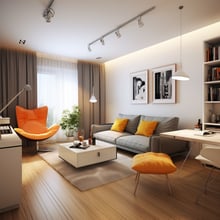Fixtures, Furnishings and Furniture: What Comes with the House?
You're at a showing for your dream home, and you fall in love with the chandelier that hangs above the dining room table. After purchasing the home, you notice something's missing. That chandelier is no longer hanging in the dining room.
What happened? Isn't that chandelier part of the home you purchased?
Not necessarily. What you get when purchasing a house depends on two factors: what you can negotiate for and the legal “definition” of the item. You can always negotiate for additional perks with your purchase in your offer, it all depends on the relative negotiating power between you and the seller and what you are willing to exchange.
What You See In The Showing
Showings are open house events in which the selling real estate agent invites prospective buyers to tour a property. The seller agent likely staged the home with nice funishings in preparation for the property to be shown. The purpose of the show furniture is to illustrate the potential of each space. The presence of a beautiful layout allows you to imagine how a buyer might treat the space more naturally. Real estate agents use the show furniture as a reference point for each potential buyer, enabling them to imagine what they would change.
Showings are an excellent way to sell a house but what if you fall in love with the show furniture and fixtures? Can you purchase them?
You are always allowed to negotiate for additional perks when you purchase a property however, you must be willing to offer something for them - whether it be monetary or some other exchange. If you ask for the show furniture, it is likely the seller will have a strong negotiation strategy and request additional compensation.
Moreover, keep in mind that the seller may not be willing to part with the furniture. Sometimes, the real estate agent will move out the seller’s original furniture and move in rented show furniture. But some sellers prefer to use their own furniture because they would rather sell their property quickly. In these scenarios, can you still get the furniture if the buyer is unwilling to part with it? The answer is interest-based negotiation.
Fixture vs. Furniture vs. Furnishing
The defining line between what comes with the property and what doesn’t depends on whether it is considered personal or real property. The law divides everything you can own into two types: personal and real. Personal property is any item that you can move, such as jewelry, cars, paper plates, boilers, jackets, and airplanes. Real property is anything that you cannot move such as buildings and land. When you purchase a piece of property, you are entitled to the “real property” – not the personal (unless you specifically negotiate for it).
Fixtures are things that are permanently or semi-permanently attached to the property. For example, fixtures might include the heating system, outdoor sheds, lamps (that are attached to the wall), built-in shelves, drawers, outlets, toilets, showerheads, faucets, and similar items that are “stuck” to the property - like the air conditioning unit.
In most sales, you keep the fixtures. The fixtures, per the law, are considered part of the home and you are thus entitled to them with the purchase of the house. However, there are some items that are borderline, like the refrigerator, microwave, chandeliers, or window-unit A/Cs. Whenever you admire an item that is semi-permanent, it could be considered a furnishing and outside the scope of the purchase. If you want one of these “semi-permanent” items, you should specifically mention it in the contract to ensure the buyer knows to leave it with the property. Typically, the seller must sell the property with the same general types of furnishing with which they purchased it but any improvements can be removed (so long as it is replaced). If you fell in love with a particular lamp or chandelier, you should specifically request it during your negotiation process. It is possible the seller intends on removing the fixture and replacing it with a different fixture. Additionally, you can also seek the assistance of an experienced San Diego real estate professional who can discuss the finer points of the law.
Finally, furniture is not connected to the property at all. Furniture includes items such as: televisions, tables, beds, couches, and chairs. Furniture is almost always considered personal property and therefore not included in the sale of the property. If you want the furniture, you will likely need to negotiate for it within your offer.
If you're looking for real estate agents who fight for you in negotiations, the agents at Steele San Diego Homes are a dynamic team who work throughout San Diego county. Their real estate agents have experience negotiating multiple offers and helping both buyers and sellers with their real estate transactions.






